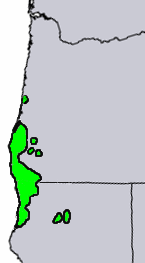Many conifers in the Pacific Northwest have a large range, sometimes extending to Alaska or California. Port Orford cedar? Not so much. It is confined to a small area along the Pacific Coast from Coos Bay, Oregon to the Klamath River in California, extending to 5000 feet in the Siskiyou Mountains. However, they may have had a greater range at one time. Or maybe some made a run to the north. They are still growing in a small area near Florence, Oregon. You can see some at the Darlingtonia State Natural Site, north of Florence.
 |
| Port Orford cedar cones |
A fire in the early 1950’s burned a wide area of Portland’s Forest Park in the vicinity of Saltzman Road. During replanting, several locations were replanted with Port Orford Cedar for some reason (probably because native seedlings were in short supply due to replanting in the Tillamook State Forest). You can find these Port Orford cedars growing in Forest Park along the Wildwood Trail at miles 14.3 and 16.6. More grow at the top of the Dogwood Trail and above Leif Erikson Drive near the junction with the Cleator Trail. Hoyt Arboretum has a few Port Orford cedars, but many have succumbed to the root fungus. Infected trees first show brown leaves in the lower branches.Two healthy ones remain along the Lookout Trail. Most of the specimens along the Redwood Trail have been lost, but some new ones that are resistant to the root disease have been planted there. These seedlings came from the Dorena Genetic Resource Center, which has been working with Oregon State University to research and grow Port Orford cedars that are resistant to the root disease.
 |
| Sign on the Redwood Trail at Hoyt Arboretum |
 |
| Port Orford cedar pollen cones |
Current uses of the wood are similar to western red cedar. The whitish wood is strong and resists rot, making it a desirable alternative to western red cedar. It became popular in Japan because of its similarity to hinoki cypress (Chamaecyparis obtusa), one of the five sacred trees of Japan and an important tree used in Japanese architecture. However, limited supply and popularity in Japan have forced up the price of Port Orford cedar to levels among the highest for any Northwest tree.



I really like the cedar cones for this conifer. Nice post!
ReplyDelete